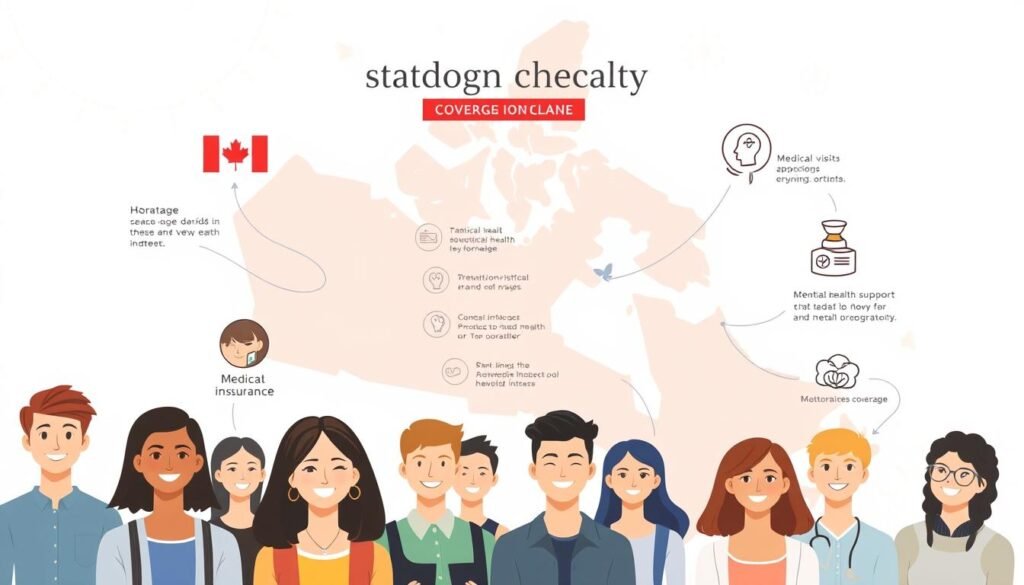
Student Health Insurance Canada Coverage Explained Clearly

Surprising fact: nearly one in three young adults faces an unexpected medical bill while studying away from home.
You need a clear map so you don’t get surprised. This guide shows how provincially funded doctor and hospital care links with private extended plans for prescriptions, dental, vision and travel.
We’ll walk you through what provincial plans pay and what private plans add, including mental counselling and virtual care options that many plans now include.
What to expect: simple checklists, realistic monthly numbers, and step-by-step ways to compare plans so you can decide whether to keep a group plan or opt out.
You’ll also find links to deeper guides Insurance and International Students and authoritative sources from government pages and provincial UHIP sites.
Tip: tables and examples appear later in the guide to help you compare per-visit caps, annual maximums and travel medical rules.
- Quick-start: how student health insurance works in Canada today
- Student health insurance Canada coverage explained
- Eligibility and program rules you should know (UHIP, OHIP, MSP and more)
- Out-of-province and out-of-country scenarios most students face
- What you’ll pay: realistic monthly costs and how premiums are set
- Comparing plans like a pro: a step-by-step checklist
- Action plan: exactly what to do next
- Get covered with confidence: your next steps and trusted resources
Quick-start: how student health insurance works in Canada today
Begin with the simple rule: public plans handle doctors and hospitals; extras come from private plans.
Provincial basics: Plans like OHIP and MSP pay for medically necessary doctor visits, hospital stays and surgeries. These are funded by taxes and managed by each province.
Private extended plans fill gaps. They add prescriptions, dental, vision, paramedical services and often emergency travel protection. You pay a premium to a provider for these extras.

Group plans at university and opt-out rules
Many universities bundle a group plan into student fees. These pooled plans are usually cheaper than buying alone.
Opt-out windows occur at the start of each intake period. If you miss the window, you typically remain enrolled until the next period.
Tip: Confirm what qualifies as "comparable coverage" before you opt out most schools require proof from another plan.
| What public plan pays | What extended plan adds | How group plans help |
|---|---|---|
| Doctor visits, hospital stays, surgeries | Prescriptions, dental, vision, physio | Lower pooled premiums; opt-out windows |
| Funded by taxes, province-run | Paid by premiums to a private provider | Often included in student fees for convenience |
| May have waiting periods for newcomers | Can include emergency travel for trips out of province | Check benefit booklet and claims process |
For budgeting help, visit StudyFinance for tips and examples. For provincial rules, check OHIP and MSP pages.
Student health insurance Canada coverage explained
Start by checking the numbers: percentages, per-visit caps and yearly maximums tell you what you’ll pay out of pocket.

What’s typically covered
Here’s what common plans include for daily healthcare needs.
- Prescription drugs: often 80% reimbursed up to $5,000 per year; vaccinations covered to $150 (inside drug max).
- Dental: $800 annual max exams & X‑rays 70%, preventive and basic oral surgery 80%, basic restorative 60%.
- Vision: $150 every 24 months for an exam, glasses or contacts.
- Paramedical: $30/visit up to 20 visits for physio, chiro, speech; combined 20 visits for naturopathy/homeopathy and for acupuncture/RMT (RMT may need MD/NP referral).
Travel and mental care highlights
Travel protection can cover trips up to 120 days, with a $5,000,000 medical incident limit, $3,000 trip cancellation and $7,500 interruption.
Mental and virtual care options often include 24/7 counselling and virtual clinics (e.g., Empower Me, Dialogue) for quick access.
Tip: Use provider portals or apps to check balances, download forms and find in-network clinics.
| Service | Typical limit | Note |
|---|---|---|
| Prescriptions | 80% up to $5,000 | Vaccines to $150 inside drug max |
| Dental | $800 annual max | Mix of 60–80% reimbursement levels |
| Paramedical | $30/visit, 20 visits | Combined maximums; referrals may apply |
For budgeting tips, visit our Insurance page and check your school or provider pages for plan specifics.
Eligibility and program rules you should know (UHIP, OHIP, MSP and more)
Know your enrolment rules early so you avoid gaps in care.

In Ontario, participating universities automatically enrol full‑time students with valid study permits into UHIP. Premiums post to your student account and renew while you remain eligible.
Ontario’s UHIP: who’s enrolled and who’s excluded
Part‑time learners, employees and dependants must apply and pay separately. Verify exceptions with your university to avoid a lapse.
International students: provincial eligibility and waiting periods
Rules vary by province. British Columbia and Saskatchewan may allow non‑citizen residents into provincial plans, sometimes with a waiting period. If you aren’t eligible, arrange a private health plan or your school’s group plan right away.
Dependants and adult children cut-offs
Spouses (common‑law after 12 months) and dependent children qualify while unmarried and living with you. Typical age limits: under 22, or under 25 if full‑time. Disabled dependants can stay covered beyond the limit.
Tip: Keep your study or work permit ready. Programs require proof of status for enrolment or renewal.
| Program | Who is eligible | Key note |
|---|---|---|
| UHIP (Ontario) | Full‑time with valid study permit | Auto‑enrol; billed to student account |
| OHIP | Qualified residents per province rules | Varies; check provincial page |
| MSP (BC) | Certain international residents | Premiums and waiting period may apply |
For more on provincial rules see a provincial guide: health insurance by province. Also check official UHIP eligibility and provincial enrollment pages (MSP, OHIP) for full details.
Out-of-province and out-of-country scenarios most students face
Crossing provincial lines or borders changes which services are paid and how claims are processed. Before you travel, check your plan rules and your home province’s fee schedule so you don’t face surprise bills.
Emergency care in another province: what’s reimbursed and what’s not
What to expect: provinces usually reimburse medically necessary doctor and hospital services when you’re away. You may need to pay up front and submit receipts later.
Tip: ambulance rides and some extras are often not fully covered outside your home province. Fee schedules differ; if the treating province charges more than your home rate, you could pay the difference.
Studying or travelling outside Canada: when you must add travel medical
If you plan travel outside the country, add travel medical if your plan doesn’t include it. Most provincial plans and many extended plans do not cover routine care abroad.
- Confirm per‑trip day limits (some plans allow 120 days) and the emergency medical limit (examples use multi‑million dollar limits).
- Keep your policy ID and emergency phone numbers handy; call your insurer before or soon after admission for coordinated care.
- Before a co‑op or field term, verify whether dental or paramedical services will reimburse by your home province’s fee guide.
Quick action: Compare travel add‑ons on our Insurance page for plan options and read provincial out‑of‑province reimbursement rules (check provincial plan pages for details).
Understanding premium drivers helps you choose the right mix of price and benefits.
Expect entry-level premiums near $61 per month if you’re healthy and choose basic extended plans. If you have pre-existing conditions or want broader limits, prices typically start around $99 and can rise to $300+ per month depending on benefits and underwriting.
Typical pricing bands
Group plans negotiated by your school often lower rates through pooled risk. Individual plans vary by insurer, selected benefits and your medical history.
How plan design affects your true cost
Deductibles and co-pays reduce premiums but raise out-of-pocket spending when you claim. For example, a higher deductible cuts monthly cost but makes you pay more at the pharmacy or clinic.
Annual maximums also matter. A $5,000 Rx limit, $30/visit paramedical with visit caps, and an $800 dental cap keep premiums moderate. But if you expect heavy use, higher limits increase monthly fees.
Tip: Estimate likely use (two cleanings, a few physio visits, occasional prescriptions) to compare price vs. risk before you buy.
| Item | Typical figure | Effect on price |
|---|---|---|
| Entry-level premium | $61/month | Lower benefits; smaller limits |
| Broader plan | $99–$300+/month | Higher limits, pre-existing acceptance |
| Key limits | Rx $5,000; Dental $800; Param. $30/visit | Higher limits raise premiums |
Watch effective dates by months and year (e.g., Sept.1–Aug.31) when budgeting. For help building a semester budget, see this budgeting guide. For insurer price ranges and definitions, check provider plan summaries.
Comparing plans like a pro: a step-by-step checklist
Before you pick a plan, list what you actually use each year this saves money and stress.
Quick note: use this checklist to compare limits, rules and convenience so you can choose a policy that fits your routine.
Create your needs list
- How often do you get dental cleanings or fillings? Count visits per academic year.
- Do you need vision benefits this cycle (exam, glasses or contacts)? Mark the month you’ll use them.
- Estimate paramedical visits: physio, RMT or chiro. Use a realistic number per term.
Read the fine print
- Compare reimbursement rates and per‑visit caps (for example, $30/visit) and annual maximums (dental $800).
- Note combined maxima: many plans share a single 20‑visit pool across practitioners.
- Confirm referral rules (e.g., RMT may need an MD/NP referral) to avoid denied claims.
Coordination of benefits
- If you’re on a parent or spouse plan, learn the sequence for claims filing to reduce out‑of‑pocket costs.
- Ask each provider about direct billing order and request a benefits summary to confirm limits.
Provider networks, virtual care and support
- Check in‑network clinics, direct billing options and whether the package includes 24/7 virtual care (Dialogue, Empower Me).
- Assess app features, claims turnaround and customer support fast service saves time during emergencies.
- Read exclusions and waiting periods so you know when benefits start.
Tip: More comparison tips at studyfinance.org. For formal definitions of coordination rules, consult insurer benefit booklets.
Action plan: exactly what to do next
Start by laying out a short, practical checklist you can follow this term. Use these steps to confirm eligibility, lock in plan details, and avoid gaps during busy months.
Verify provincial eligibility and waiting periods
Step 1: Check your province’s rules and any waiting period. If a delay applies, line up temporary cover so you’re not uninsured.
Confirm your university group plan and opt-out windows
Step 2: Read your group plan summary. Note deadlines, proof required to opt out, and whether the plan meets your needs.
Add travel medical for trips or co-op outside your province
Step 3: If you’ll travel, add travel medical or confirm per-trip day limits (for example, 120 days). Carry policy ID and call your assistance provider in emergencies.
- Step 4: List expected use dental visits, prescriptions and physio and check caps and combined maxima to avoid mid-term surprises.
- Step 5: Set reminders a few months before renewal months or the main policy period so you can update dependants or opt-out choices in time.
- Step 6: Save your provider’s assistance phone number and policy ID on your phone and wallet for quick support.
| Action | Why it matters | Quick target |
|---|---|---|
| Check provincial rules | Avoid gaps from waiting periods | Before arrival or within enrolment months |
| Review group plan | Know deadlines and opt-out proof | At intake or policy renewals (e.g., Sept–Aug) |
| Add travel medical | Protect trips, co-op and study abroad | Before travel; confirm per-trip day limit |
Get covered with confidence: your next steps and trusted resources
Confirm a few facts now and you’ll protect yourself all year.
Check your province rules, your study status and whether you are auto‑enrolled in a group plan or must apply. If you’re an international student in British Columbia or elsewhere, verify program eligibility, premiums and any waiting periods (UHIP, MSP, OHIP).
Build a shortlist of extended health plans that match how you use care: prescriptions, paramedical visits, mental support, virtual clinics and travel emergency medical limits. Prioritize easy claims and strong provider networks.
For next steps. Check official UHIP, BC MSP, OHIP and Government of Canada guidance. Save your provider support number and bookmark your digital benefits card for fast access.
If you want to know other articles similar to Student Health Insurance Canada Coverage Explained Clearly you can visit the category Finance.






Leave a Reply